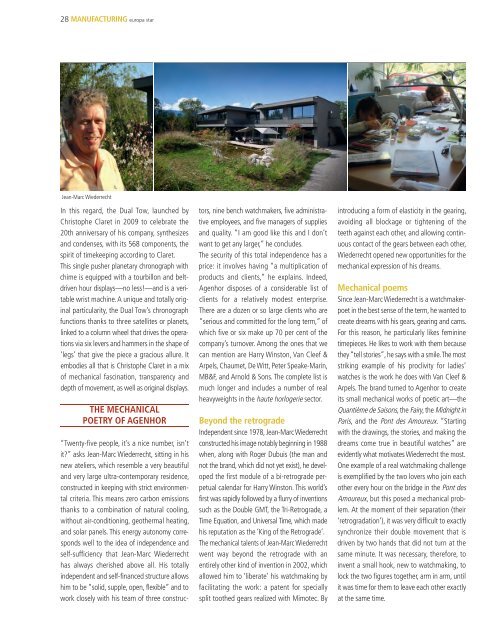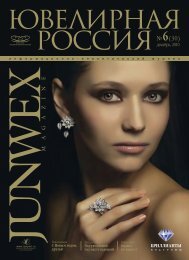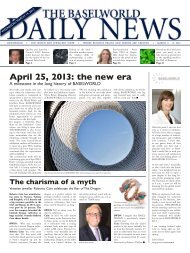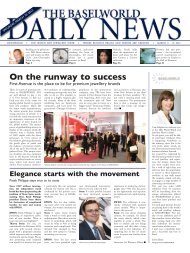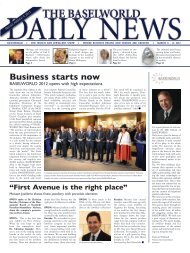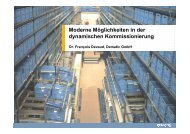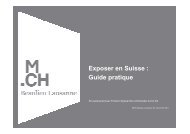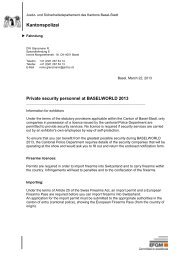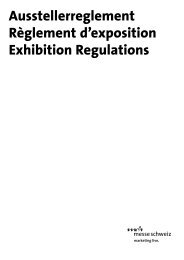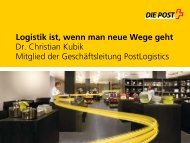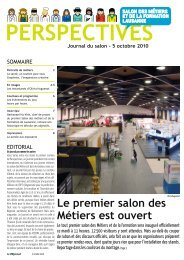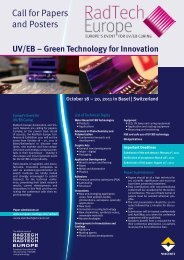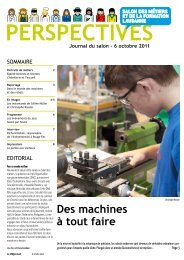MASTER MECHANICS
MASTER MECHANICS
MASTER MECHANICS
You also want an ePaper? Increase the reach of your titles
YUMPU automatically turns print PDFs into web optimized ePapers that Google loves.
28 MANUFACTURING europa star<br />
Jean-Marc Wiederrecht<br />
In this regard, the Dual Tow, launched by<br />
Christophe Claret in 2009 to celebrate the<br />
20th anniversary of his company, synthesizes<br />
and condenses, with its 568 components, the<br />
spirit of timekeeping according to Claret.<br />
This single pusher planetary chronograph with<br />
chime is equipped with a tourbillon and beltdriven<br />
hour displays—no less!—and is a veritable<br />
wrist machine.A unique and totally original<br />
particularity, the Dual Tow’s chronograph<br />
functions thanks to three satellites or planets,<br />
linked to a column wheel that drives the operations<br />
via six levers and hammers in the shape of<br />
‘legs’ that give the piece a gracious allure. It<br />
embodies all that is Christophe Claret in a mix<br />
of mechanical fascination, transparency and<br />
depth of movement, as well as original displays.<br />
THE MECHANICAL<br />
POETRY OF AGENHOR<br />
“Twenty-five people, it’s a nice number, isn’t<br />
it?” asks Jean-Marc Wiederrecht, sitting in his<br />
new ateliers, which resemble a very beautiful<br />
and very large ultra-contemporary residence,<br />
constructed in keeping with strict environmental<br />
criteria. This means zero carbon emissions<br />
thanks to a combination of natural cooling,<br />
without air-conditioning, geothermal heating,<br />
and solar panels. This energy autonomy corresponds<br />
well to the idea of independence and<br />
self-sufficiency that Jean-Marc Wiederrecht<br />
has always cherished above all. His totally<br />
independent and self-financed structure allows<br />
him to be “solid, supple, open, flexible” and to<br />
work closely with his team of three construc-<br />
tors, nine bench watchmakers, five administrative<br />
employees, and five managers of supplies<br />
and quality. “I am good like this and I don’t<br />
want to get any larger,” he concludes.<br />
The security of this total independence has a<br />
price: it involves having “a multiplication of<br />
products and clients,” he explains. Indeed,<br />
Agenhor disposes of a considerable list of<br />
clients for a relatively modest enterprise.<br />
There are a dozen or so large clients who are<br />
“serious and committed for the long term,” of<br />
which five or six make up 70 per cent of the<br />
company’s turnover. Among the ones that we<br />
can mention are Harry Winston, Van Cleef &<br />
Arpels, Chaumet, De Witt, Peter Speake-Marin,<br />
MB&F, and Arnold & Sons. The complete list is<br />
much longer and includes a number of real<br />
heavyweights in the haute horlogerie sector.<br />
Beyond the retrograde<br />
Independent since 1978, Jean-MarcWiederrecht<br />
constructed his image notably beginning in 1988<br />
when, along with Roger Dubuis (the man and<br />
not the brand, which did not yet exist), he developed<br />
the first module of a bi-retrograde perpetual<br />
calendar for Harry Winston. This world’s<br />
first was rapidly followed by a flurry of inventions<br />
such as the Double GMT, the Tri-Retrograde, a<br />
Time Equation, and Universal Time, which made<br />
his reputation as the ‘King of the Retrograde’.<br />
The mechanical talents of Jean-Marc Wiederrecht<br />
went way beyond the retrograde with an<br />
entirely other kind of invention in 2002, which<br />
allowed him to ‘liberate’ his watchmaking by<br />
facilitating the work: a patent for specially<br />
split toothed gears realized with Mimotec. By<br />
introducing a form of elasticity in the gearing,<br />
avoiding all blockage or tightening of the<br />
teeth against each other, and allowing continuous<br />
contact of the gears between each other,<br />
Wiederrecht opened new opportunities for the<br />
mechanical expression of his dreams.<br />
Mechanical poems<br />
Since Jean-Marc Wiederrecht is a watchmakerpoet<br />
in the best sense of the term, he wanted to<br />
create dreams with his gears, gearing and cams.<br />
For this reason, he particularly likes feminine<br />
timepieces. He likes to work with them because<br />
they“tell stories”,he says with a smile.The most<br />
striking example of his proclivity for ladies’<br />
watches is the work he does with Van Cleef &<br />
Arpels. The brand turned to Agenhor to create<br />
its small mechanical works of poetic art—the<br />
Quantième de Saisons,the Fairy,the Midnight in<br />
Paris, and the Pont des Amoureux. “Starting<br />
with the drawings, the stories, and making the<br />
dreams come true in beautiful watches” are<br />
evidently what motivates Wiederrecht the most.<br />
One example of a real watchmaking challenge<br />
is exemplified by the two lovers who join each<br />
other every hour on the bridge in the Pont des<br />
Amoureux, but this posed a mechanical problem.<br />
At the moment of their separation (their<br />
‘retrogradation’), it was very difficult to exactly<br />
synchronize their double movement that is<br />
driven by two hands that did not turn at the<br />
same minute. It was necessary, therefore, to<br />
invent a small hook, new to watchmaking, to<br />
lock the two figures together, arm in arm, until<br />
it was time for them to leave each other exactly<br />
at the same time.


